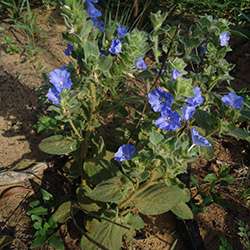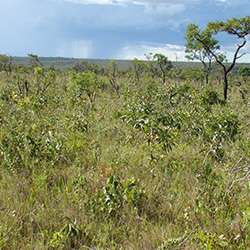The plants of the Brazilian savanna recover vigorously after fire and flourish in the open vegetation maintained by fire. These species require abundant light, and are at risk of disappearing where forest encroaches due to fire suppression. Credit: Natashi Pilon.
A North Carolina State University study shows that fire suppression efforts in Brazilian savannas turn many of those areas into forest lands, with negative consequences for the plants and animals that live there.
Expanding forests suck up CO2 from the atmosphere, but the plants and animals from savannas struggle to cope in the leafier environments. Encroaching forest resulted in major losses of plant and ant species in those areas over the last 30 years - with the most susceptible plants and ants losing massive numbers of species.
William Hoffmann, professor of plant and microbial biology at NC State and co-corresponding author of a paper on biodiversity in the Brazilian Cerrado, said that the study shows the importance of fire to the savanna. Savannas - pure grasslands and grasslands dotted with trees - cover about 20 percent of the earth's land; the Brazilian Cerrado is considered the earth's most biodiverse savanna.
The plant and animal species of savannas are highly adapted to frequent fires and high light," Hoffmann said. "Shady conditions are an enemy to these savanna dwellers. Many of these plant species just can't persist in a forest. However, fire suppression has taken root in Brazil, so there is a reluctance to allow fires - even to promote the health of the savanna."
Fire helps keep savannas healthy. Credit: William Hoffmann, NC State University.
The study, published in Science Advances, examined the past 30 years in the Brazilian Cerrado - a time period that highlights the influence of fire suppression and subsequent forest encroachment. Hoffmann and colleagues from Brazil found that this savanna captured and stored a lot more carbon in the past three decades, but also found that, in areas fully encroached by forest, plant species declined by 27 percent and ant species declined by 35 percent.
Perhaps more importantly, Hoffmann said, losses of plant and ant species unique to the savanna were even more widespread. Savanna plants declined by two-thirds in lands that converted from savanna to forest, while savanna ants declined by a whopping 86 percent.
"These savanna species can't be moved and can't really live anywhere else," Hoffmann said. "This study really highlights the extent to which these species are dependent on their savanna homes."
The findings could have more far-ranging implications, as Hoffmann added that he would expect to find similar results in other tropical areas where savannas become degraded by suppressing fire.
Drone footage showing how forest lands encroach tropical savannas. Plants and ants native to tropical savannas disappear when forests encroach. Credit: William Hoffmann, NC State University
More information: "The biodiversity cost of carbon sequestration in tropical savanna," Science Advances (2017). DOI: 10.1126/sciadv.1701284
Journal information: Science Advances
Provided by North Carolina State University

























